Chinese Literati Painters: History, Features, and Comparisons
VerifiedAdded on 2021/05/31
|6
|1579
|182
Essay
AI Summary
This essay provides a comprehensive overview of Chinese Literati painters, delving into their historical context, key features, and cultural significance. It begins by contrasting the lack of Literati painters in Western art history with the prominence of this class in China, highlighting the unique characteristics of their art form, which combines elements of graphical art, poetry, and calligraphy. The essay traces the history of Literati art from the Bei Song dynasty to the Ming dynasty, explaining the concept of Wenrenhua, where scholar painters prioritize personal expression over literal representation. It explores the lineages of Literati painters, particularly the Southern School and the Wu School, and discusses the core elements of Literati paintings, including character, knowledge, talent, and thinking. The essay emphasizes the self-entertainment aspect of the art and its distinctiveness compared to Western art. The conclusion reiterates the unique style of Literati painting and its historical importance, emphasizing its contribution to Chinese culture and art.
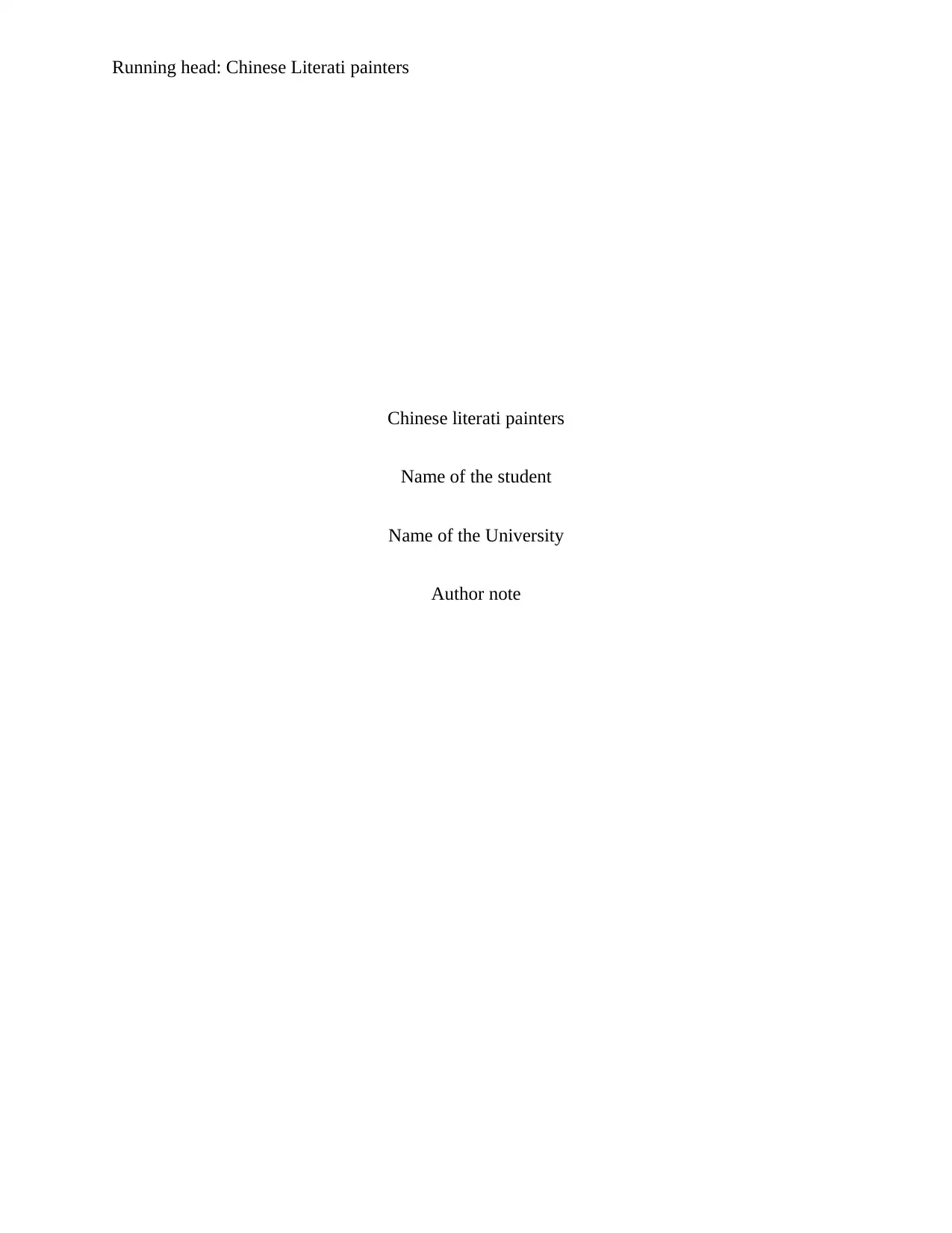
Running head: Chinese Literati painters
Chinese literati painters
Name of the student
Name of the University
Author note
Chinese literati painters
Name of the student
Name of the University
Author note
Paraphrase This Document
Need a fresh take? Get an instant paraphrase of this document with our AI Paraphraser
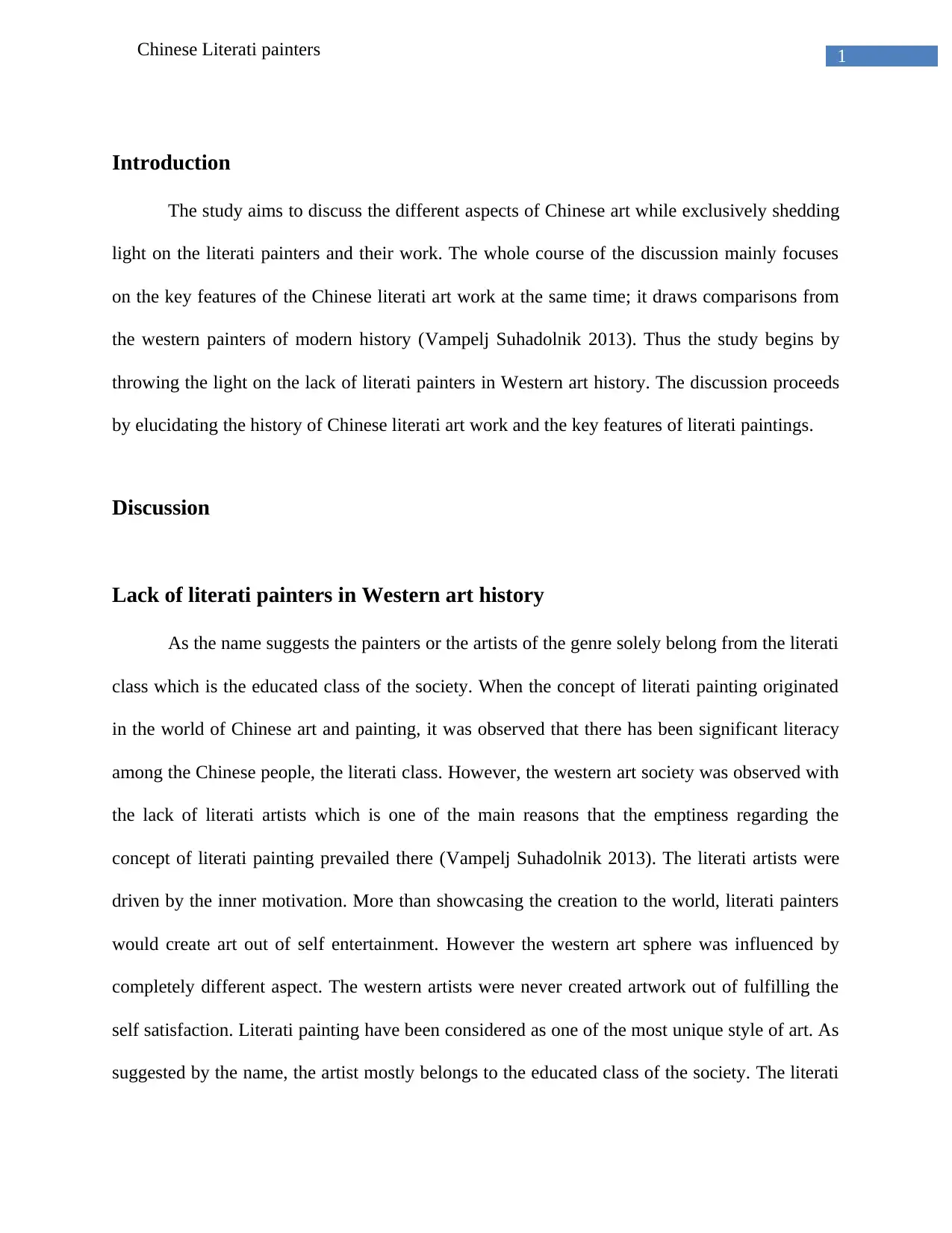
1Chinese Literati painters
Introduction
The study aims to discuss the different aspects of Chinese art while exclusively shedding
light on the literati painters and their work. The whole course of the discussion mainly focuses
on the key features of the Chinese literati art work at the same time; it draws comparisons from
the western painters of modern history (Vampelj Suhadolnik 2013). Thus the study begins by
throwing the light on the lack of literati painters in Western art history. The discussion proceeds
by elucidating the history of Chinese literati art work and the key features of literati paintings.
Discussion
Lack of literati painters in Western art history
As the name suggests the painters or the artists of the genre solely belong from the literati
class which is the educated class of the society. When the concept of literati painting originated
in the world of Chinese art and painting, it was observed that there has been significant literacy
among the Chinese people, the literati class. However, the western art society was observed with
the lack of literati artists which is one of the main reasons that the emptiness regarding the
concept of literati painting prevailed there (Vampelj Suhadolnik 2013). The literati artists were
driven by the inner motivation. More than showcasing the creation to the world, literati painters
would create art out of self entertainment. However the western art sphere was influenced by
completely different aspect. The western artists were never created artwork out of fulfilling the
self satisfaction. Literati painting have been considered as one of the most unique style of art. As
suggested by the name, the artist mostly belongs to the educated class of the society. The literati
Introduction
The study aims to discuss the different aspects of Chinese art while exclusively shedding
light on the literati painters and their work. The whole course of the discussion mainly focuses
on the key features of the Chinese literati art work at the same time; it draws comparisons from
the western painters of modern history (Vampelj Suhadolnik 2013). Thus the study begins by
throwing the light on the lack of literati painters in Western art history. The discussion proceeds
by elucidating the history of Chinese literati art work and the key features of literati paintings.
Discussion
Lack of literati painters in Western art history
As the name suggests the painters or the artists of the genre solely belong from the literati
class which is the educated class of the society. When the concept of literati painting originated
in the world of Chinese art and painting, it was observed that there has been significant literacy
among the Chinese people, the literati class. However, the western art society was observed with
the lack of literati artists which is one of the main reasons that the emptiness regarding the
concept of literati painting prevailed there (Vampelj Suhadolnik 2013). The literati artists were
driven by the inner motivation. More than showcasing the creation to the world, literati painters
would create art out of self entertainment. However the western art sphere was influenced by
completely different aspect. The western artists were never created artwork out of fulfilling the
self satisfaction. Literati painting have been considered as one of the most unique style of art. As
suggested by the name, the artist mostly belongs to the educated class of the society. The literati
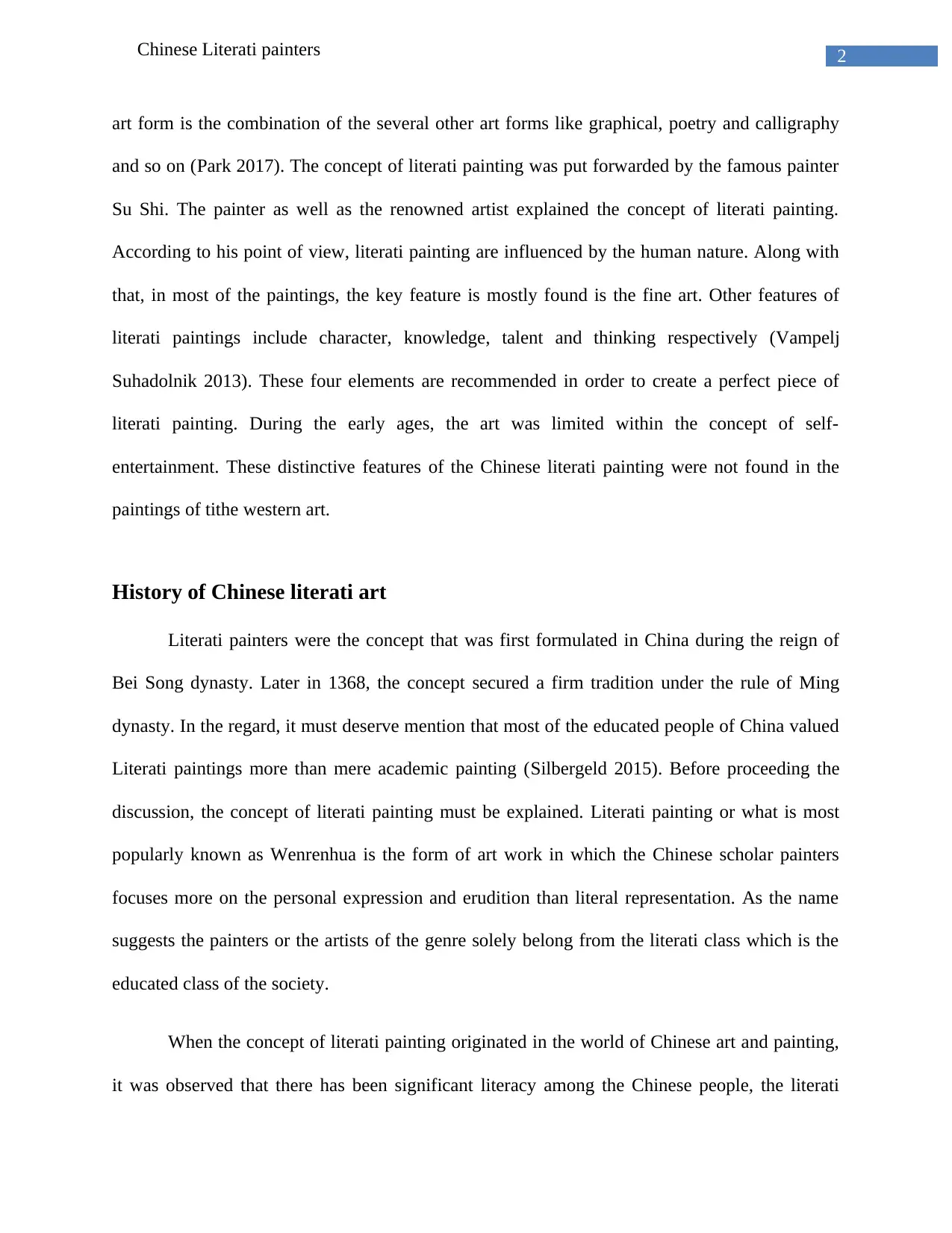
2Chinese Literati painters
art form is the combination of the several other art forms like graphical, poetry and calligraphy
and so on (Park 2017). The concept of literati painting was put forwarded by the famous painter
Su Shi. The painter as well as the renowned artist explained the concept of literati painting.
According to his point of view, literati painting are influenced by the human nature. Along with
that, in most of the paintings, the key feature is mostly found is the fine art. Other features of
literati paintings include character, knowledge, talent and thinking respectively (Vampelj
Suhadolnik 2013). These four elements are recommended in order to create a perfect piece of
literati painting. During the early ages, the art was limited within the concept of self-
entertainment. These distinctive features of the Chinese literati painting were not found in the
paintings of tithe western art.
History of Chinese literati art
Literati painters were the concept that was first formulated in China during the reign of
Bei Song dynasty. Later in 1368, the concept secured a firm tradition under the rule of Ming
dynasty. In the regard, it must deserve mention that most of the educated people of China valued
Literati paintings more than mere academic painting (Silbergeld 2015). Before proceeding the
discussion, the concept of literati painting must be explained. Literati painting or what is most
popularly known as Wenrenhua is the form of art work in which the Chinese scholar painters
focuses more on the personal expression and erudition than literal representation. As the name
suggests the painters or the artists of the genre solely belong from the literati class which is the
educated class of the society.
When the concept of literati painting originated in the world of Chinese art and painting,
it was observed that there has been significant literacy among the Chinese people, the literati
art form is the combination of the several other art forms like graphical, poetry and calligraphy
and so on (Park 2017). The concept of literati painting was put forwarded by the famous painter
Su Shi. The painter as well as the renowned artist explained the concept of literati painting.
According to his point of view, literati painting are influenced by the human nature. Along with
that, in most of the paintings, the key feature is mostly found is the fine art. Other features of
literati paintings include character, knowledge, talent and thinking respectively (Vampelj
Suhadolnik 2013). These four elements are recommended in order to create a perfect piece of
literati painting. During the early ages, the art was limited within the concept of self-
entertainment. These distinctive features of the Chinese literati painting were not found in the
paintings of tithe western art.
History of Chinese literati art
Literati painters were the concept that was first formulated in China during the reign of
Bei Song dynasty. Later in 1368, the concept secured a firm tradition under the rule of Ming
dynasty. In the regard, it must deserve mention that most of the educated people of China valued
Literati paintings more than mere academic painting (Silbergeld 2015). Before proceeding the
discussion, the concept of literati painting must be explained. Literati painting or what is most
popularly known as Wenrenhua is the form of art work in which the Chinese scholar painters
focuses more on the personal expression and erudition than literal representation. As the name
suggests the painters or the artists of the genre solely belong from the literati class which is the
educated class of the society.
When the concept of literati painting originated in the world of Chinese art and painting,
it was observed that there has been significant literacy among the Chinese people, the literati
⊘ This is a preview!⊘
Do you want full access?
Subscribe today to unlock all pages.

Trusted by 1+ million students worldwide
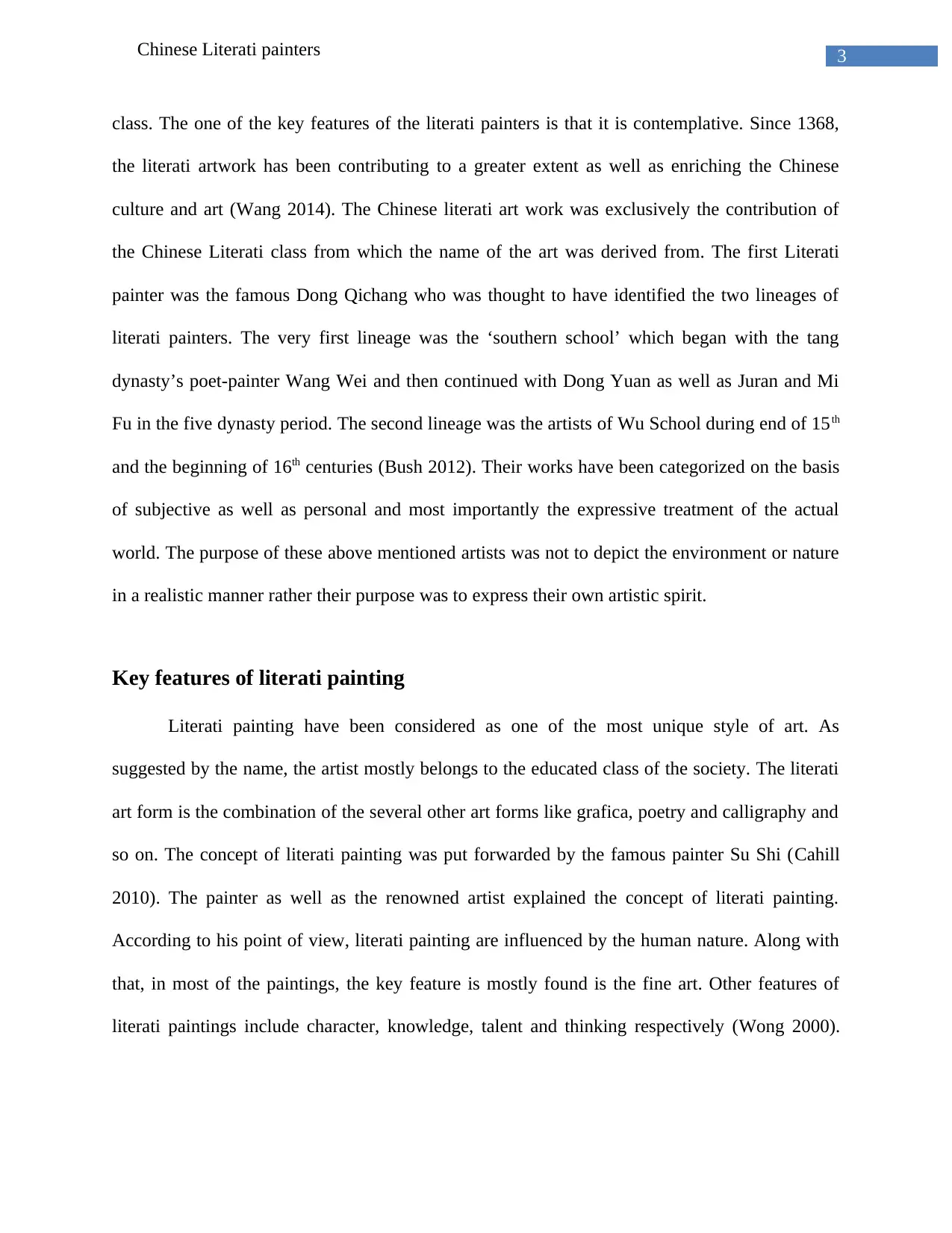
3Chinese Literati painters
class. The one of the key features of the literati painters is that it is contemplative. Since 1368,
the literati artwork has been contributing to a greater extent as well as enriching the Chinese
culture and art (Wang 2014). The Chinese literati art work was exclusively the contribution of
the Chinese Literati class from which the name of the art was derived from. The first Literati
painter was the famous Dong Qichang who was thought to have identified the two lineages of
literati painters. The very first lineage was the ‘southern school’ which began with the tang
dynasty’s poet-painter Wang Wei and then continued with Dong Yuan as well as Juran and Mi
Fu in the five dynasty period. The second lineage was the artists of Wu School during end of 15th
and the beginning of 16th centuries (Bush 2012). Their works have been categorized on the basis
of subjective as well as personal and most importantly the expressive treatment of the actual
world. The purpose of these above mentioned artists was not to depict the environment or nature
in a realistic manner rather their purpose was to express their own artistic spirit.
Key features of literati painting
Literati painting have been considered as one of the most unique style of art. As
suggested by the name, the artist mostly belongs to the educated class of the society. The literati
art form is the combination of the several other art forms like grafica, poetry and calligraphy and
so on. The concept of literati painting was put forwarded by the famous painter Su Shi (Cahill
2010). The painter as well as the renowned artist explained the concept of literati painting.
According to his point of view, literati painting are influenced by the human nature. Along with
that, in most of the paintings, the key feature is mostly found is the fine art. Other features of
literati paintings include character, knowledge, talent and thinking respectively (Wong 2000).
class. The one of the key features of the literati painters is that it is contemplative. Since 1368,
the literati artwork has been contributing to a greater extent as well as enriching the Chinese
culture and art (Wang 2014). The Chinese literati art work was exclusively the contribution of
the Chinese Literati class from which the name of the art was derived from. The first Literati
painter was the famous Dong Qichang who was thought to have identified the two lineages of
literati painters. The very first lineage was the ‘southern school’ which began with the tang
dynasty’s poet-painter Wang Wei and then continued with Dong Yuan as well as Juran and Mi
Fu in the five dynasty period. The second lineage was the artists of Wu School during end of 15th
and the beginning of 16th centuries (Bush 2012). Their works have been categorized on the basis
of subjective as well as personal and most importantly the expressive treatment of the actual
world. The purpose of these above mentioned artists was not to depict the environment or nature
in a realistic manner rather their purpose was to express their own artistic spirit.
Key features of literati painting
Literati painting have been considered as one of the most unique style of art. As
suggested by the name, the artist mostly belongs to the educated class of the society. The literati
art form is the combination of the several other art forms like grafica, poetry and calligraphy and
so on. The concept of literati painting was put forwarded by the famous painter Su Shi (Cahill
2010). The painter as well as the renowned artist explained the concept of literati painting.
According to his point of view, literati painting are influenced by the human nature. Along with
that, in most of the paintings, the key feature is mostly found is the fine art. Other features of
literati paintings include character, knowledge, talent and thinking respectively (Wong 2000).
Paraphrase This Document
Need a fresh take? Get an instant paraphrase of this document with our AI Paraphraser
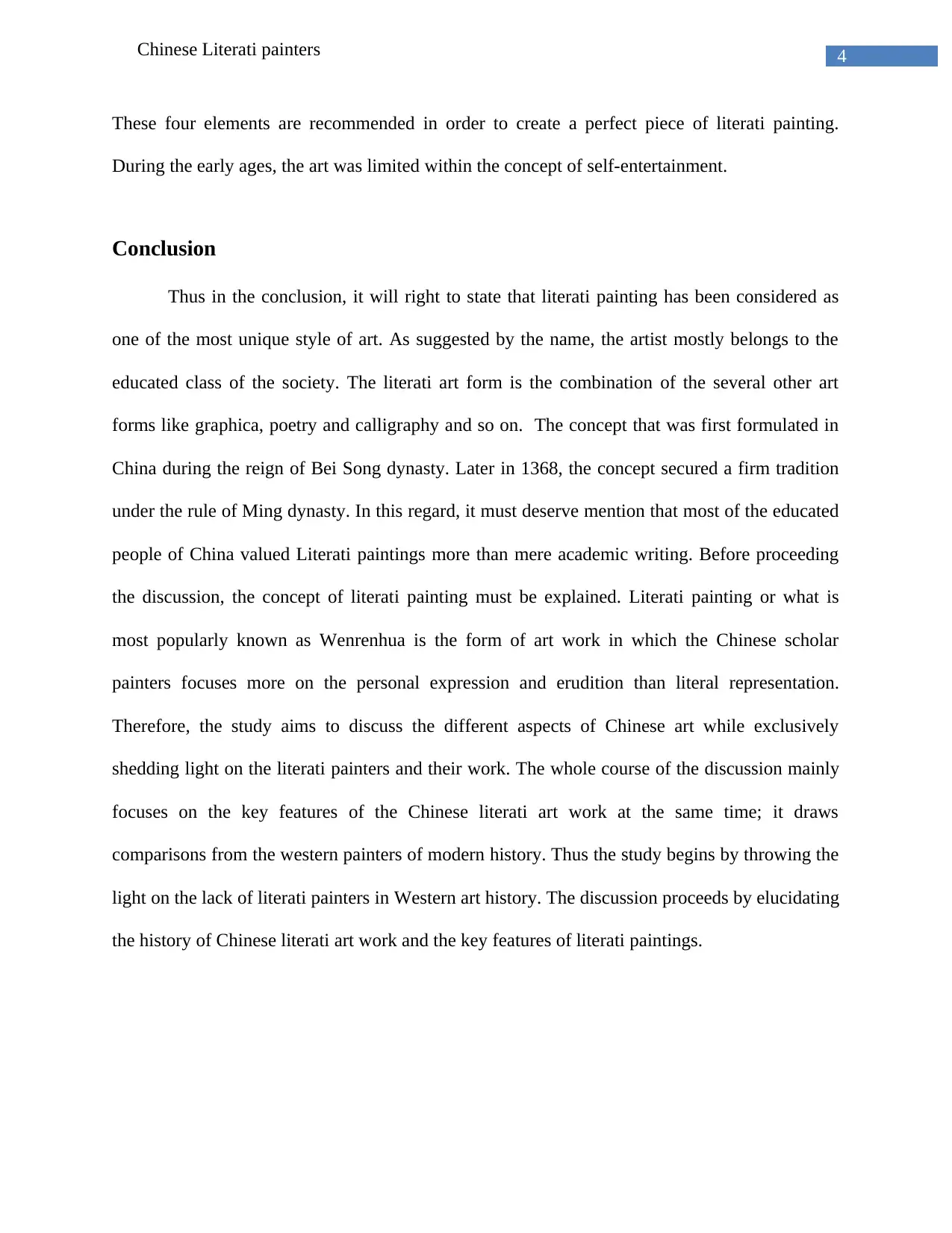
4Chinese Literati painters
These four elements are recommended in order to create a perfect piece of literati painting.
During the early ages, the art was limited within the concept of self-entertainment.
Conclusion
Thus in the conclusion, it will right to state that literati painting has been considered as
one of the most unique style of art. As suggested by the name, the artist mostly belongs to the
educated class of the society. The literati art form is the combination of the several other art
forms like graphica, poetry and calligraphy and so on. The concept that was first formulated in
China during the reign of Bei Song dynasty. Later in 1368, the concept secured a firm tradition
under the rule of Ming dynasty. In this regard, it must deserve mention that most of the educated
people of China valued Literati paintings more than mere academic writing. Before proceeding
the discussion, the concept of literati painting must be explained. Literati painting or what is
most popularly known as Wenrenhua is the form of art work in which the Chinese scholar
painters focuses more on the personal expression and erudition than literal representation.
Therefore, the study aims to discuss the different aspects of Chinese art while exclusively
shedding light on the literati painters and their work. The whole course of the discussion mainly
focuses on the key features of the Chinese literati art work at the same time; it draws
comparisons from the western painters of modern history. Thus the study begins by throwing the
light on the lack of literati painters in Western art history. The discussion proceeds by elucidating
the history of Chinese literati art work and the key features of literati paintings.
These four elements are recommended in order to create a perfect piece of literati painting.
During the early ages, the art was limited within the concept of self-entertainment.
Conclusion
Thus in the conclusion, it will right to state that literati painting has been considered as
one of the most unique style of art. As suggested by the name, the artist mostly belongs to the
educated class of the society. The literati art form is the combination of the several other art
forms like graphica, poetry and calligraphy and so on. The concept that was first formulated in
China during the reign of Bei Song dynasty. Later in 1368, the concept secured a firm tradition
under the rule of Ming dynasty. In this regard, it must deserve mention that most of the educated
people of China valued Literati paintings more than mere academic writing. Before proceeding
the discussion, the concept of literati painting must be explained. Literati painting or what is
most popularly known as Wenrenhua is the form of art work in which the Chinese scholar
painters focuses more on the personal expression and erudition than literal representation.
Therefore, the study aims to discuss the different aspects of Chinese art while exclusively
shedding light on the literati painters and their work. The whole course of the discussion mainly
focuses on the key features of the Chinese literati art work at the same time; it draws
comparisons from the western painters of modern history. Thus the study begins by throwing the
light on the lack of literati painters in Western art history. The discussion proceeds by elucidating
the history of Chinese literati art work and the key features of literati paintings.
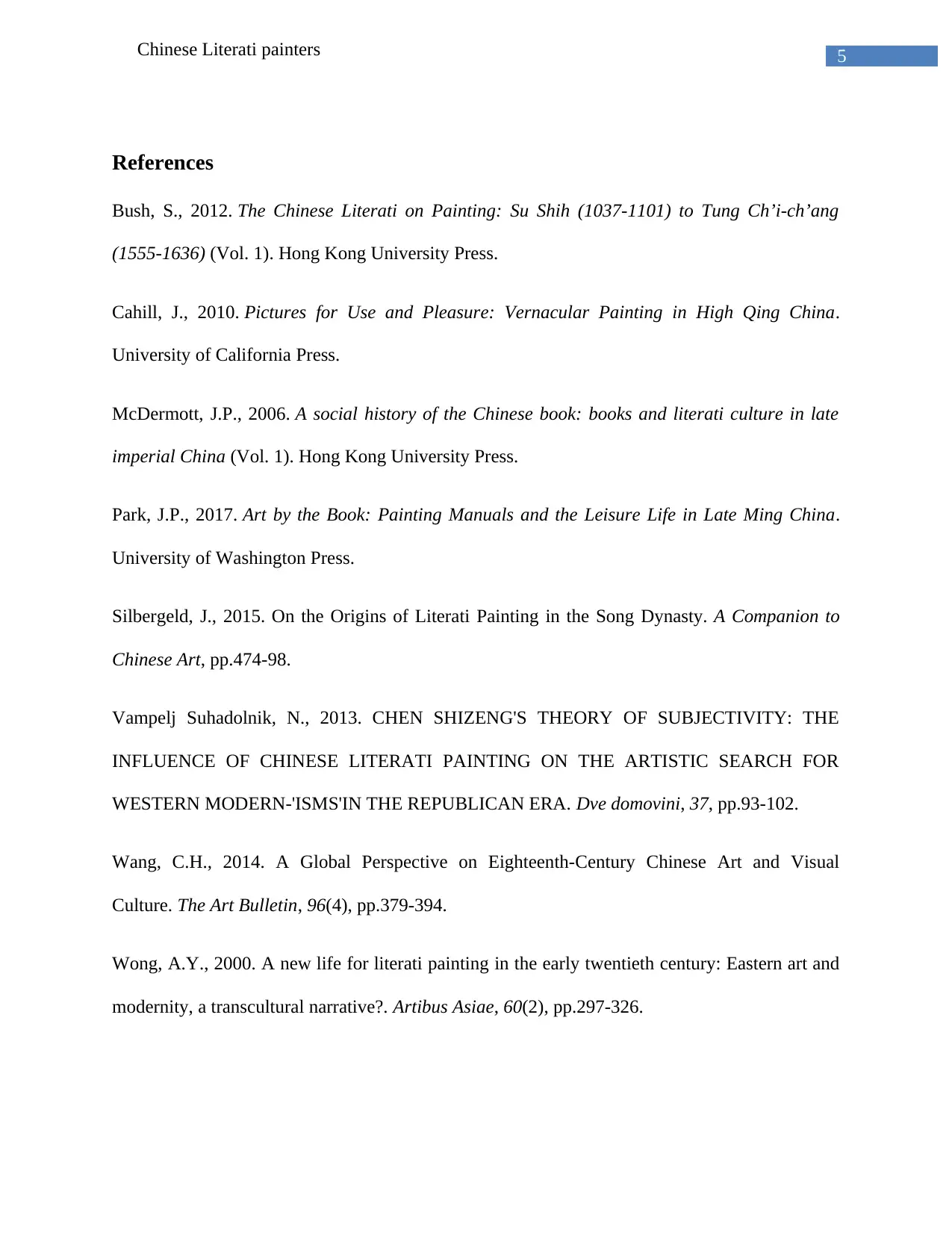
5Chinese Literati painters
References
Bush, S., 2012. The Chinese Literati on Painting: Su Shih (1037-1101) to Tung Ch’i-ch’ang
(1555-1636) (Vol. 1). Hong Kong University Press.
Cahill, J., 2010. Pictures for Use and Pleasure: Vernacular Painting in High Qing China.
University of California Press.
McDermott, J.P., 2006. A social history of the Chinese book: books and literati culture in late
imperial China (Vol. 1). Hong Kong University Press.
Park, J.P., 2017. Art by the Book: Painting Manuals and the Leisure Life in Late Ming China.
University of Washington Press.
Silbergeld, J., 2015. On the Origins of Literati Painting in the Song Dynasty. A Companion to
Chinese Art, pp.474-98.
Vampelj Suhadolnik, N., 2013. CHEN SHIZENG'S THEORY OF SUBJECTIVITY: THE
INFLUENCE OF CHINESE LITERATI PAINTING ON THE ARTISTIC SEARCH FOR
WESTERN MODERN-'ISMS'IN THE REPUBLICAN ERA. Dve domovini, 37, pp.93-102.
Wang, C.H., 2014. A Global Perspective on Eighteenth-Century Chinese Art and Visual
Culture. The Art Bulletin, 96(4), pp.379-394.
Wong, A.Y., 2000. A new life for literati painting in the early twentieth century: Eastern art and
modernity, a transcultural narrative?. Artibus Asiae, 60(2), pp.297-326.
References
Bush, S., 2012. The Chinese Literati on Painting: Su Shih (1037-1101) to Tung Ch’i-ch’ang
(1555-1636) (Vol. 1). Hong Kong University Press.
Cahill, J., 2010. Pictures for Use and Pleasure: Vernacular Painting in High Qing China.
University of California Press.
McDermott, J.P., 2006. A social history of the Chinese book: books and literati culture in late
imperial China (Vol. 1). Hong Kong University Press.
Park, J.P., 2017. Art by the Book: Painting Manuals and the Leisure Life in Late Ming China.
University of Washington Press.
Silbergeld, J., 2015. On the Origins of Literati Painting in the Song Dynasty. A Companion to
Chinese Art, pp.474-98.
Vampelj Suhadolnik, N., 2013. CHEN SHIZENG'S THEORY OF SUBJECTIVITY: THE
INFLUENCE OF CHINESE LITERATI PAINTING ON THE ARTISTIC SEARCH FOR
WESTERN MODERN-'ISMS'IN THE REPUBLICAN ERA. Dve domovini, 37, pp.93-102.
Wang, C.H., 2014. A Global Perspective on Eighteenth-Century Chinese Art and Visual
Culture. The Art Bulletin, 96(4), pp.379-394.
Wong, A.Y., 2000. A new life for literati painting in the early twentieth century: Eastern art and
modernity, a transcultural narrative?. Artibus Asiae, 60(2), pp.297-326.
⊘ This is a preview!⊘
Do you want full access?
Subscribe today to unlock all pages.

Trusted by 1+ million students worldwide
1 out of 6
Your All-in-One AI-Powered Toolkit for Academic Success.
+13062052269
info@desklib.com
Available 24*7 on WhatsApp / Email
![[object Object]](/_next/static/media/star-bottom.7253800d.svg)
Unlock your academic potential
Copyright © 2020–2025 A2Z Services. All Rights Reserved. Developed and managed by ZUCOL.

